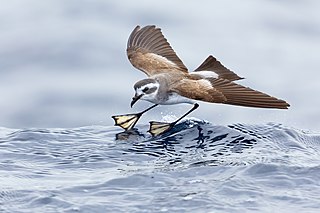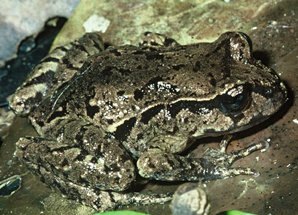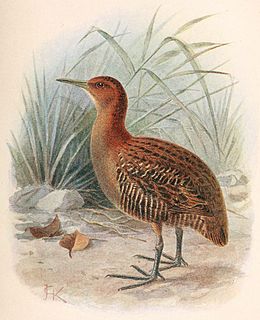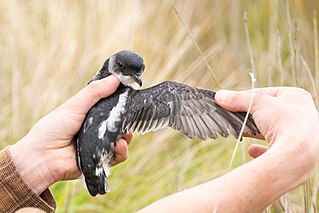
The white-faced storm petrel, also known as white-faced petrel is a small seabird of the austral storm petrel family Oceanitidae. It is the only member of the monotypic genus Pelagodroma.

The Otago shag,, together with the Foveaux shag formerly known as the Stewart Island shag and in its dark phase as the bronze shag, is a species of shag now found only in coastal Otago, New Zealand.

The Chatham petrel or ranguru (Maori) is a medium-sized, grey, white and black gadfly petrel. It only breeds on the Chatham Islands, New Zealand, and until recently was restricted to the 218-hectare Rangatira or South-East Island.

The Subantarctic snipe is a species of snipe endemic to New Zealand's subantarctic islands. The Maori call it "Tutukiwi". The nominate race C. a. aucklandica is found on the Auckland Islands. Other subspecies include C. a. meinertzhagenae from the Antipodes Islands, and C. a. perseverance from Campbell Island. The former subspecies from the Snares Islands has been separated as a full species, the Snares snipe, as have the extinct South Island and North Island snipes.

The Maud Island frog is a primitive frog native to New Zealand, one of only four extant species belonging to the family Leiopelmatidae.
Brian Douglas Bell was a New Zealand environmental consultant and ornithologist.

The austral snipes, also known as the New Zealand snipes or tutukiwi, are a genus, Coenocorypha, of tiny birds in the sandpiper family, which are now only found on New Zealand's outlying islands. There are currently three living species and six known extinct species, with the Subantarctic snipe having three subspecies, including the Campbell Island snipe discovered as recently as 1997. The genus was once distributed from Fiji, New Caledonia and Norfolk Island, across New Zealand and southwards into New Zealand's subantarctic islands, but predation by introduced species, especially rats, has drastically reduced their range.

The shore plover, also known as the shore dotterel or by its Māori name of tuturuatu, is a small plover endemic to New Zealand. Once found all around the New Zealand coast, it is now restricted to a few offshore islands. It is one of the world's rarest shorebirds: the population is roughly 200.

The Auckland rail is a small nearly flightless rail endemic to the Auckland Islands 460 km south of New Zealand. It is somewhat of a biogeographical anomaly, being the only species in the genus Lewinia to have reached the islands of New Zealand, skipping over the main islands to reach the remote Auckland group. Its closest relative is Lewin's rail of Australia. The species is currently restricted to two islands in the Auckland group, Adams Island and Disappointment Island.

Xylotoles costatus, the Pitt Island longhorn beetle, is a species of beetle in the family Cerambycidae. It is endemic to the Chatham Islands. Once thought to be extinct, it is now known to survive on South East Island/Rangatira; being therefore an example of a so-called "Lazarus taxon".

Hakawai, also Hokioi in the North Island, was to the New Zealand Māori people, a mythological bird that was sometimes heard but not usually seen. It is now associated with the nocturnal aerial displays made by Coenocorypha snipe.
Forbes's snipe was a species of New Zealand snipe endemic to the Chatham Islands. It was the larger of two species found there, the smaller being the surviving Chatham snipe. It was never seen alive by scientists and is known only from fossil material collected on the islands. Why it became extinct while its smaller relative survived is a mystery, as is the exact timing of its extinction, although it may have survived, unnoticed, until the 15th century.

The Campbell snipe, also known as the Campbell Island snipe, is a rare subspecies of the Subantarctic snipe, endemic to Campbell Island, a subantarctic island south of New Zealand in the Southern Ocean. It was not formally described until January 2010. The subspecific name alludes to the name of the sealing brig Perseverance, captained by Frederick Hasselborough, that discovered Campbell Island in 1810, and which probably inadvertently introduced rats to the island when it was wrecked there in 1828.
The South Island snipe, also known as the Stewart Island snipe or tutukiwi in Māori, is an extinct species of bird in the sandpiper family Scolopacidae that was endemic to New Zealand.

The North Island snipe, also known as the little barrier snipe or tutukiwi, is an extinct species of bird in the sandpiper family, Scolopacidae, that was endemic to New Zealand.

Hadramphus spinipennis, commonly called the coxella weevil, is a large, nocturnal, flightless weevil only found on Mangere and Rangatira Islands in the Chatham Islands, New Zealand.

The Whenua Hou diving-petrel is a highly endangered subspecies of the South Georgia diving petrel that is endemic to New Zealand.

Critter of the Week is a weekly RNZ National programme about endangered and neglected native plants and animals of New Zealand.
















